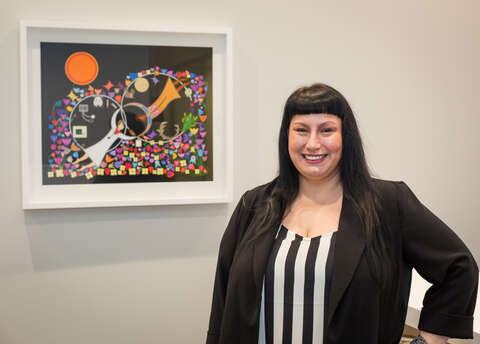Mobile Menu
- Education
- Research
-
Students
- High School Outreach
- Undergraduate & Beyond: Community of Support
- Current Students
- Faculty & Staff
- Alumni
- News & Events
- Giving
- About


Lisa Boivin is a member of the Deninu K’ue First Nation in the Northwest Territories. She is also a bioethics student and interdisciplinary artist who creates paintings, poetry and image-based stories to bridge gaps between bioethics and aspects of Indigenous culture. Boivin is the student editor of the Indigenous Healthcare section in Ars Medica, a journal of medicine, the arts and humanities. Her painting, Sharing Bioethics, was included in the The Body Electric digital art exhibit at the Royal College of Physicians and Surgeons of Canada’s International Conference on Residency Education last fall and is now on display in the Faculty of Medicine’s Enrolment Services office.
Name: Lisa Boivin
Program/Year: Bioethics Specialist in the Faculty of Arts and Science, Fifth Year
Role/Position: Interdisciplinary Artist
What inspired you to create your work, Sharing Bioethics?
Sharing Bioethics came about when my Mother asked me, “Lisa what do you do? How do I explain it?” My Mother knows what bioethics is and she understands aspects of my Dene culture, but she wasn’t sure how I marry the two academically. I told her I would paint her an image-based story so she could understand. The painting is overflowing with bioethical, medical, familial and Dene stories. My Mother is connected to all of them. In the painting I am sharing bioethics with a clinician; in real life I am sharing bioethics with my mother. In this way I honor my mother. Sharing Bioethics is an honor song for her.
What motivated you to become an artist?
I have always been artistically inclined, writing poetry, stories and taking photographs. Painting is something different. It developed out of necessity. As certain academic tasks became too difficult to respond to linguistically, I learned to paint. My first paintings, Residential School Series, started as an essay I could not write. Painting is a way of knowing, a connection to the ancestors and knowledges that are thousands of years old. I realize in the academic world my explanation sounds strange but it is the only way I can explain my ability to paint and translate knowledge. I am not a classically trained artist I have only been painting for 17 months.
What drew you to the field of bioethics?
Bioethics tells a range of beautiful and meaningful stories, and I fell in love with these narratives. There are stories that have to be exchanged within bioethics to make sure an action is right or good. I wanted to learn those stories and maybe add a few of my own to the academic discipline of bioethics.
How can art help to bridge gaps between bioethics and Indigenous wisdom and knowledge?
There are colonial boundaries in bioethics because the systems of communication are not universal. Bioethics relies heavily on academic and clinical approaches that employ linguistic and written methods to translate knowledge. Visual representation of the human experience and moral behavior is rarely utilized. However, answers to ethical questions don’t have to be housed in academic writing.
In Dene culture, there are certain ethical stories that cannot be confined in the structure of printed words. I illustrate these stories and situate the ethics in my paintings. These paintings dismantle the colonial boundaries in bioethics and bestow cultural teachings that lead to solutions.
What is you favorite thing about the Faculty of Medicine?
My favorite thing about the Faculty of Medicine isn’t a thing, but a person. Rochelle Allan is the Indigenous Peoples’ Program Coordinator at the Office of Indigenous Medical Education. She is largely responsible for my success as an artist and an image-based storyteller. She saw something in my art immediately and encouraged me to develop it further. Rochelle introduced me to several people, which resulted in a multitude of opportunities. I am extremely lucky to have met her.